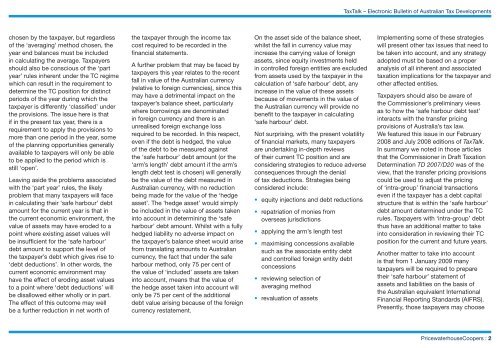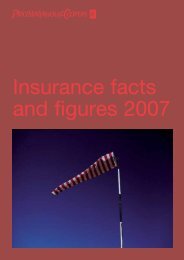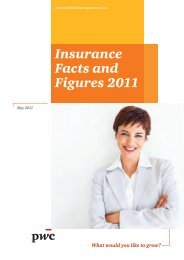Thin capitalisation: eroding asset values and increasing debt ... - PwC
Thin capitalisation: eroding asset values and increasing debt ... - PwC
Thin capitalisation: eroding asset values and increasing debt ... - PwC
Create successful ePaper yourself
Turn your PDF publications into a flip-book with our unique Google optimized e-Paper software.
TaxTalk – Electronic Bulletin of Australian Tax Developments<br />
chosen by the taxpayer, but regardless<br />
of the ‘averaging’ method chosen, the<br />
year end balances must be included<br />
in calculating the average. Taxpayers<br />
should also be conscious of the ‘part<br />
year’ rules inherent under the TC regime<br />
which can result in the requirement to<br />
determine the TC position for distinct<br />
periods of the year during which the<br />
taxpayer is differently ‘classified’ under<br />
the provisions. The issue here is that<br />
if in the present tax year, there is a<br />
requirement to apply the provisions to<br />
more than one period in the year, some<br />
of the planning opportunities generally<br />
available to taxpayers will only be able<br />
to be applied to the period which is<br />
still ‘open’.<br />
Leaving aside the problems associated<br />
with the ‘part year’ rules, the likely<br />
problem that many taxpayers will face<br />
in calculating their ‘safe harbour’ <strong>debt</strong><br />
amount for the current year is that in<br />
the current economic environment, the<br />
value of <strong>asset</strong>s may have eroded to a<br />
point where existing <strong>asset</strong> <strong>values</strong> will<br />
be insufficient for the ‘safe harbour’<br />
<strong>debt</strong> amount to support the level of<br />
the taxpayer’s <strong>debt</strong> which gives rise to<br />
‘<strong>debt</strong> deductions’. In other words, the<br />
current economic environment may<br />
have the effect of <strong>eroding</strong> <strong>asset</strong> <strong>values</strong><br />
to a point where ‘<strong>debt</strong> deductions’ will<br />
be disallowed either wholly or in part.<br />
The effect of this outcome may well<br />
be a further reduction in net worth of<br />
the taxpayer through the income tax<br />
cost required to be recorded in the<br />
financial statements.<br />
A further problem that may be faced by<br />
taxpayers this year relates to the recent<br />
fall in value of the Australian currency<br />
(relative to foreign currencies), since this<br />
may have a detrimental impact on the<br />
taxpayer’s balance sheet, particularly<br />
where borrowings are denominated<br />
in foreign currency <strong>and</strong> there is an<br />
unrealised foreign exchange loss<br />
required to be recorded. In this respect,<br />
even if the <strong>debt</strong> is hedged, the value<br />
of the <strong>debt</strong> to be measured against<br />
the ‘safe harbour’ <strong>debt</strong> amount (or the<br />
‘arm’s length’ <strong>debt</strong> amount if the arm’s<br />
length <strong>debt</strong> test is chosen) will generally<br />
be the value of the <strong>debt</strong> measured in<br />
Australian currency, with no reduction<br />
being made for the value of the ‘hedge<br />
<strong>asset</strong>’. The ‘hedge <strong>asset</strong>’ would simply<br />
be included in the value of <strong>asset</strong>s taken<br />
into account in determining the ‘safe<br />
harbour’ <strong>debt</strong> amount. Whilst with a fully<br />
hedged liability no adverse impact on<br />
the taxpayer’s balance sheet would arise<br />
from translating amounts to Australian<br />
currency, the fact that under the safe<br />
harbour method, only 75 per cent of<br />
the value of ‘included’ <strong>asset</strong>s are taken<br />
into account, means that the value of<br />
the hedge <strong>asset</strong> taken into account will<br />
only be 75 per cent of the additional<br />
<strong>debt</strong> value arising because of the foreign<br />
currency restatement.<br />
On the <strong>asset</strong> side of the balance sheet,<br />
whilst the fall in currency value may<br />
increase the carrying value of foreign<br />
<strong>asset</strong>s, since equity investments held<br />
in controlled foreign entities are excluded<br />
from <strong>asset</strong>s used by the taxpayer in the<br />
calculation of ‘safe harbour’ <strong>debt</strong>, any<br />
increase in the value of these <strong>asset</strong>s<br />
because of movements in the value of<br />
the Australian currency will provide no<br />
benefit to the taxpayer in calculating<br />
‘safe harbour’ <strong>debt</strong>.<br />
Not surprising, with the present volatility<br />
of financial markets, many taxpayers<br />
are undertaking in-depth reviews<br />
of their current TC position <strong>and</strong> are<br />
considering strategies to reduce adverse<br />
consequences through the denial<br />
of tax deductions. Strategies being<br />
considered include:<br />
• equity injections <strong>and</strong> <strong>debt</strong> reductions<br />
• repatriation of monies from<br />
overseas jurisdictions<br />
• applying the arm’s length test<br />
• maximising concessions available<br />
such as the associate entity <strong>debt</strong><br />
<strong>and</strong> controlled foreign entity <strong>debt</strong><br />
concessions<br />
• reviewing selection of<br />
averaging method<br />
• revaluation of <strong>asset</strong>s<br />
Implementing some of these strategies<br />
will present other tax issues that need to<br />
be taken into account, <strong>and</strong> any strategy<br />
adopted must be based on a proper<br />
analysis of all inherent <strong>and</strong> associated<br />
taxation implications for the taxpayer <strong>and</strong><br />
other affected entities.<br />
Taxpayers should also be aware of<br />
the Commissioner’s preliminary views<br />
as to how the ‘safe harbour <strong>debt</strong> test’<br />
interacts with the transfer pricing<br />
provisions of Australia’s tax law.<br />
We featured this issue in our February<br />
2008 <strong>and</strong> July 2008 editions of TaxTalk.<br />
In summary we noted in those articles<br />
that the Commissioner in Draft Taxation<br />
Determination TD 2007/D20 was of the<br />
view, that the transfer pricing provisions<br />
could be used to adjust the pricing<br />
of ‘intra-group’ financial transactions<br />
even if the taxpayer has a <strong>debt</strong> capital<br />
structure that is within the ‘safe harbour’<br />
<strong>debt</strong> amount determined under the TC<br />
rules. Taxpayers with ‘intra-group’ <strong>debt</strong><br />
thus have an additional matter to take<br />
into consideration in reviewing their TC<br />
position for the current <strong>and</strong> future years.<br />
Another matter to take into account<br />
is that from 1 January 2009 many<br />
taxpayers will be required to prepare<br />
their ‘safe harbour’ statement of<br />
<strong>asset</strong>s <strong>and</strong> liabilities on the basis of<br />
the Australian equivalent International<br />
Financial Reporting St<strong>and</strong>ards (AIFRS).<br />
Presently, those taxpayers may choose<br />
PricewaterhouseCoopers :
















